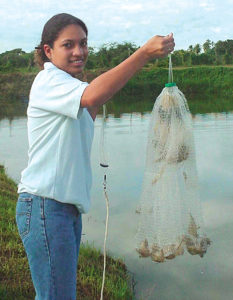
Bioencapsulated artemia show promise for therapeutant delivery to young fish
Research with sockeye salmon fry in Washington state demonstrates that bioencapsulated artemia can deliver therapeutic erythromycin more efficiently than pelleted feeds.
Consideration of the effect of animal density usually does not include the critically important contribution of pathogen concentration to the dynamics of disease outbreaks.

Research with sockeye salmon fry in Washington state demonstrates that bioencapsulated artemia can deliver therapeutic erythromycin more efficiently than pelleted feeds.

In intensive fish hatcheries, successful larval rearing depends upon meeting larval metabolic demands with continuous feeding.

A study of hybrid tilapia breeding represents the minimum scale needed for achieving successful, in-house selective breeding.

Physical and chemical processes, along with the biological and economic components of shrimp production in zero-exchange culture, require models for analysis.

OceanBoy Farms in Southern Central Florida has been a leader in establishing commercial protocols for inland, low-salinity shrimp farms.

Inland shrimp farming in Ecuador started in mid-2000, when traditional producers were at their lowest point due to the White Spot Syndrome Virus.

Consumer interest in water quality may prompt industry to further limit chemical use and improve biosecurity programs as an alternative to antibiotics.

Construction of an intensive aquaculture production facility without serious attention to biosecurity nearly guarantees outbreaks of infectious disease.

Panama shrimp farmers looking to boost production in the presence of White Spot Syndrome Virus have tried various strategies, including freshwater systems.

Future increases in U.S. shrimp farming are likely to be inland, which entails the use of ground waters with an ion concentration vastly different from seawater.

Although three Honduras hatcheries have shrimp postlarvae maturation units, only GML of Seafarm International has achieved consistent production with recirculation.

To be successfully conditioned to spawn in captivity, most marine fish species must be exposed to temperature and light cycles that mimic their seasonal changes in nature.

"Tasteless smoke” – a purified extract of wood smoke with particulate matter removed – has a mystifying ring to it, but is a straightforward concept.

Olive flounders fed a diet containing 45 percent crude protein at 4,000 kcal/kg appeared to utilize feed more efficiently than fish fed the other diets.

A promising strain of Nile tilapia is the genetically male tilapia that results from the mating of sex-reversed female fingerlings with normal females.